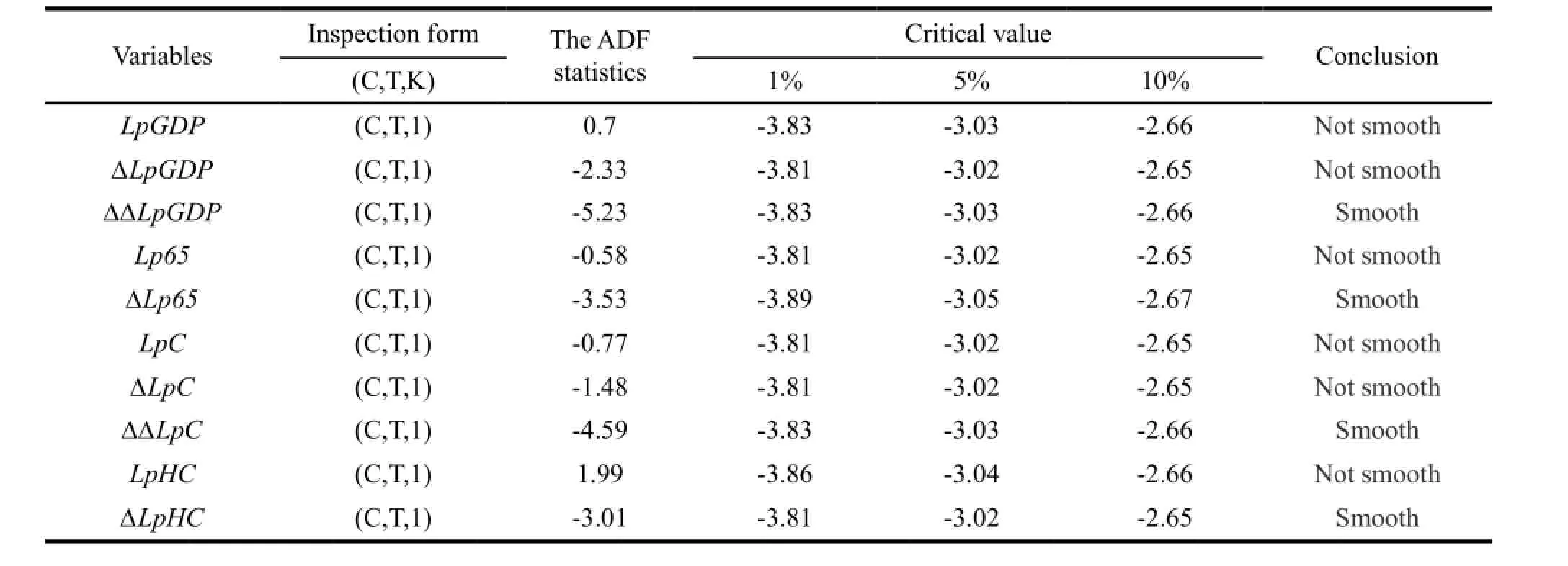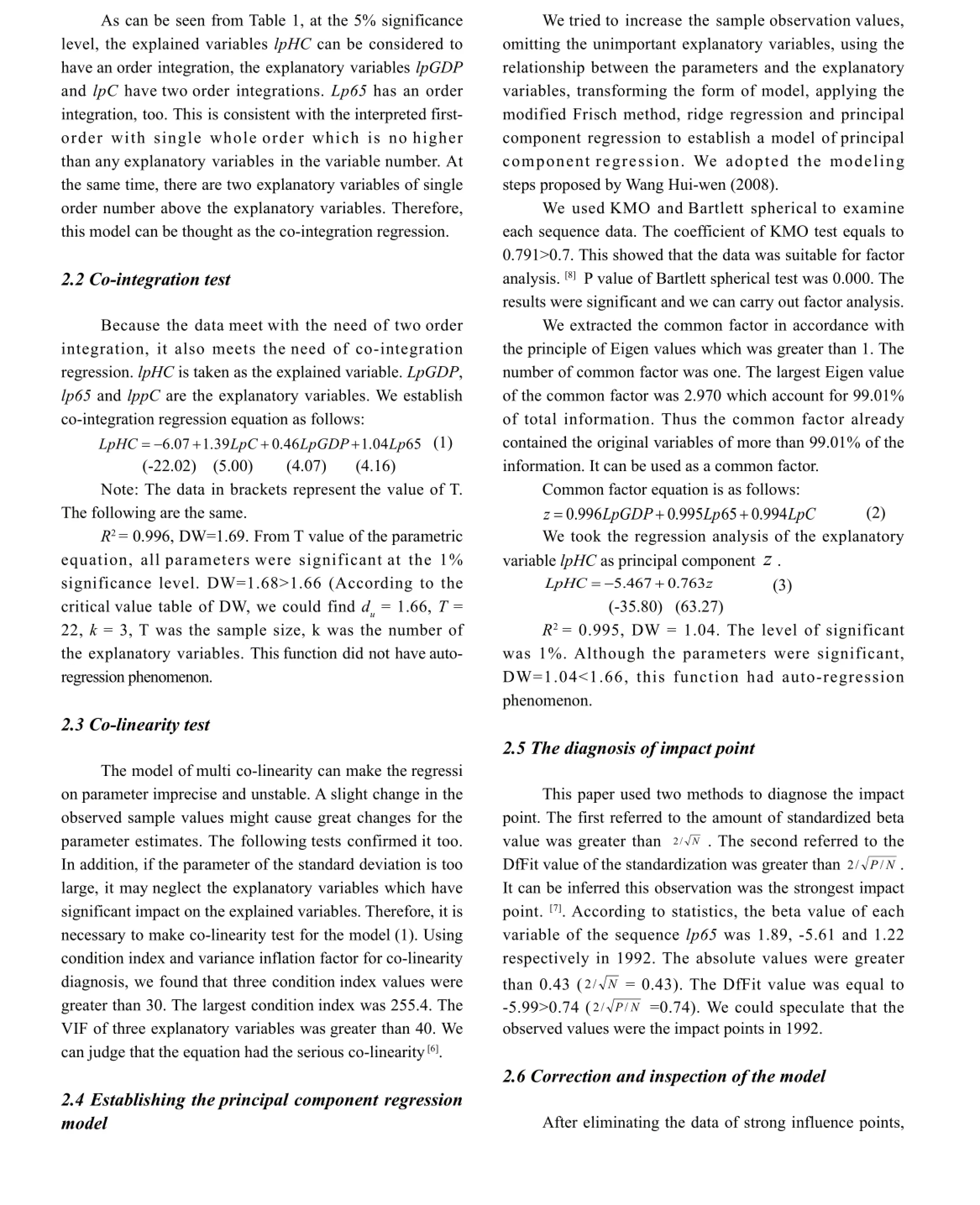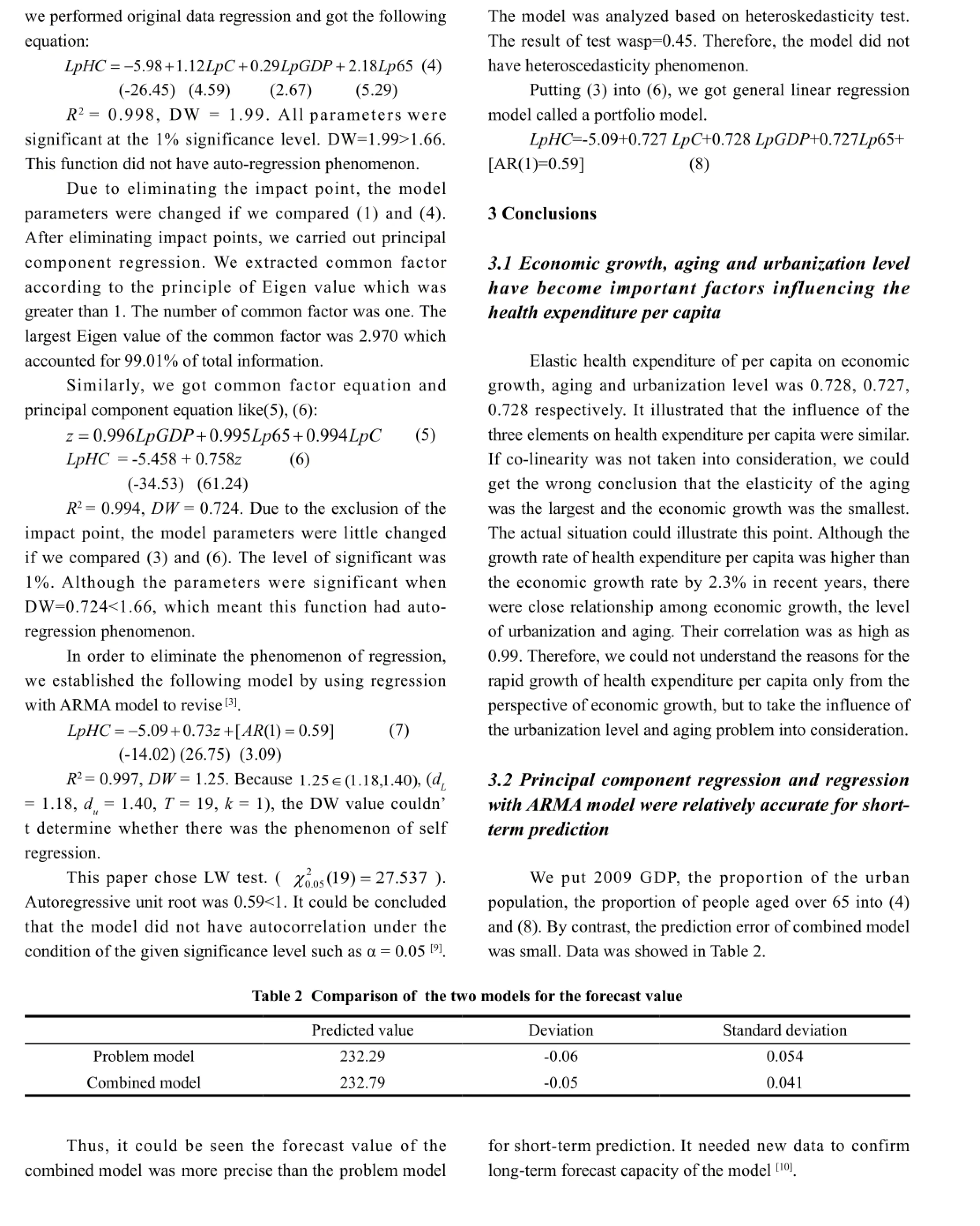Analysis of Factors Influencing per Capita Healthcare Expenses
-- Based on the Empirical Analysis of Principal Component Regression Model and Regression with ARMA Model
FU Shu-yong, SUN Shu-jun
(1.School of Business Administration, Shenyang Pharmaceutical University, Shenyang 110016, China; 2.Ideological and Political Department, Liaoning Institute of Science and Technology, Benxi 117022, China)
Analysis of Factors Influencing per Capita Healthcare Expenses
-- Based on the Empirical Analysis of Principal Component Regression Model and Regression with ARMA Model
FU Shu-yong1, SUN Shu-jun2
(1.School of Business Administration, Shenyang Pharmaceutical University, Shenyang 110016, China; 2.Ideological and Political Department, Liaoning Institute of Science and Technology, Benxi 117022, China)
Objective To analyze the factors that influence per capita healthcare expenses in China. Methods Data stability, influential point, linear, autoregressive model, heteroscedasticity were put into principal component regression model and regression with ARMA model. The tests showed parameters were relatively remarkable. Model quality and the short-term forecast effect were good, too. Results and Conclusion It can been seen that these factors such as economic level, urbanization level and aging population are the main factors and they work equally.
principal component; regression with ARMA model; per capita healthcare expense; level of urbanization; aging population
According to the data from the Ministry of Public Health that between 1987 and 2008, the average growth rate of per capita health expenditure was 11.1% and the growth rate of GDP was 8.8%. (After excluding the price factor). Especially in recent few years, the average growth rate of per capita health expenditure was greater than average growth of GDP, which caused the problem of fair health resources distribution, such as, “it is expensive and difficult to see a doctor”. On one hand, the growing costs have improved the people’s health and living standards. On the other hand, our health system ref orm also faced some challenges, such as the proportion of health expenditure per capita, GDP per capita, individual payment ratio, factors influencing health system reform etc.
At present, there are more documents study on the relationship between health expenditure and GDP[1,2]. The majority of the research adopted such method as single factor regression, panel data method, co-integrated method, structural mutation, unit root test, error correction model etc. There are less studies concerning about per capita health expenditure. Elizabeth and other experts have studied the factors of health costs[3]. They studied the effects of the variables on health expenditure in Singapore with GDP. There variables included the ratio between public health expe nditure and the total health spending, the number of doctors per thousand people, female participation rate and the proportion o f people over 60. Chen Hong-hai and other people studied the effect of GDP, ages, urbanization level on public health per capita. Though some literature adopted multiple regressions for empirically study, it did not have an essential test for parameters and model. In fact, such problems as nonstationary, co-linearity and heteroskedasticity exist in the actual economic data. If we ignore these tests, there will be serious problems[4].
Therefore, this paper overcame the shortcomings of less empirical study on the health expenditure per capita. We used China’s 20 years data to establish principal component regression model and regression with ARMA model. By testing all kinds of parameters and models, we developed a multiple regression model with the level of economic development, ages, urbanization level and health demand.
1 Indicator, data and methods
1.1 Factors influencing health expenditure per capita
As to the factors that affect health expenditure per capita, Huang Cheng-li (2004) believed that the aging of population has a greater influence on the growth of health expenditure. Ge Yi and other people (2006) thought that the investment of medical equipment and medical expense can affect health-care expenses. Chen Hong-hai (2009) believed that GDP, aging of population, urbanization level influence the health expenditure per capita, and this hypothesis is consistent with China’s national conditions. GDP is a comprehensive evaluation indicator for a country’s economic development. Health costs can reflect the national demand for health care. As GDP increases, the demand for medical care will increase which is the basic assumptions for most literature research. In addition, the aging of population increase the desire to purchase social medical and health services. A rise in GDP per capita will create increased purchasing power, thus forming the demand for medical services[5]. Urbanization improves the living standards of migrant farmers and their medical condition, which may lead to the increase of total health expenditure. Therefore, this paper selected GDP per capita, the proportion of people aged over 65 as factors influencing the health expenditure per capita.
1.2 Data sources
Because the data of China’s population over the age of 65 is inconsistent each year, which result in the difficulty of collecting it. So we can only choose the data from 1985 to 2008 and it was from China Statistical Yearbook. Health expenditure per capita and GDP per capita data were from China Health Statistics Yearbook of 2009, the data of consumer price index and urbanization level was from China Statistical Yearbook of 2009. We used the health expenditure per capita, nominal GDP per capita divided by the consumer price index to eliminate the non-stationary data.
1.3 Methods
This paper focused on the relationship between the economic level, the level of urbanization, population aging and the demand for health services. Therefore, we established the demand function pHC=f(pGDP,pC,p65), pGDP referred to per capita GDP which represents economic development. pC referred to the proportion of the urban population which represents the level of urbanization in China. p65 referred to the proportion of people aged 65 or much older which represents the degree of the aged. pHC referred to per capita health expenditure which represents h ealth service demand.
Time series data logarithm was taken to remove the phenomenon of heteroscedasticity. Variable names were lpGDP, lpC, lp65, and lpHC respectively.
2 Empirical analysis
2.1 Stationary test
Most of the time series data were non-stationary data. When we used non-stationary data regression analysis, it was prone to get spurious regression. Therefore, before performing regression analysis, we must conduct unit root test.

Table 1 Unit root stationary test of ADF


3.3 The main reason for the proportion of personal expenditure to the total health expenditure
From the proportion of health expenditure per capita to the GDP per capita in the past three decades, three stages could be divided, first stage was from 1978 to 1988, second stage was from 1988 to 1999 and the last stage was from 2000 to 2008. In the first phase, the proportion of personal spending to the total health costs was 26.2% and the proportion in the third phase was 54.1%, which meant the percentage of it has doubled. It could be inferred that the rise of the proportion of personal expenditure to the total health expenditure was the main reason to cause overburdened health cost.
[1] HUANG Cheng-li. Relationship between Demographic Factors and Health Costs [J]. Population Studies, 2004, (5): 24-30.
[2] GE Yi. Growth of Health Care Costs Related to Research and Medical Equipment Investment [J]. Mathematical Statistics and Management, 2006, (1): 105-110.
[3] ZHANG Xiao-dong. Number of Applications in Economics [M]. Beijing: Mechanical Industry Press, 2009: 308-330.
[4] ( U.S.) • L. Bruce Stanley , etc. History of Economic Thought [M]. Beijing: Peking University Press, 2008: 285-296.
[5] CHEN Hong-hai, HUANG Cheng. Three Factors of Total Health Costs [J]. Harbin Institute of Technology Journal, 2009, 12: 316-320.
[6] LI Zhi-hui, LUO Ping. SPSS for Windows Statistical Analysis [M]. Beijing Electronic Industry Press, 2005: 308-320.
[7] FU De-yin. Factor Analysis to Explore Statistical Test System [J]. Statistical Research, 2007, (6): 86-90.
[8] ZHANG Wen-tong. SPSS Statistical Analysis Advanced Tutorial [M]. Beijing: Higher Education Press, 2004: 215-230.
[9] WANG Wen, WANG Jie, HUANG Hai-jun. Multimodal. Principal Component Regression Modeling Strategy Study [J]. Beijing University of Aeronautics and Astronautics, 2008, (6): 661-664.
[10] FU Shu-yong, SUN Shu-jun. Unified Procurement of Essential Drugs Conditions Pricing Model [J]. Chinese Health Economics, 2010, (6): 45-46.
Author’s information: FU Shu-yong, Lecturer. Major research area: Health economics. Tel: 024-23986543, E-mail: fushuyong888@163. com
- 亚洲社会药学杂志的其它文章
- Evaluation of Subjective Indicators for Medical Consumables Based on Fuzzy Group Decision-Making Methods
- Hospital Outpatient Drug Repercussion: Risks and Countermeasures
- Key Factors on Online Pharmacy Management Based on the Analytic Hierarchy Process in China
- The Safety Monitoring System for Drug Clinical Trials
- Diagnostic Reagent Industry in China: SWOT Analysis and Countermeasures
- International Trade Status of Chinese Medicinal Materials from 2000 to 2012

